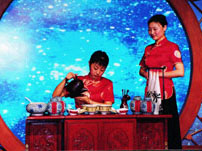 China is the homeland of tea; and it is believed to have had tea shrubs for over 5,000 years. The cultivation of tea plants dates back 2,000 years.
China is the homeland of tea; and it is believed to have had tea shrubs for over 5,000 years. The cultivation of tea plants dates back 2,000 years.
According to the different methods by which it is processed, Chinese tea can be classified into four categories: green tea, black tea, oolong tea, and scented tea. Green tea is the variety that keeps the original color of its leaves and is not fermented during processing. Black tea is fermented before baking and is comparably dark. Oolong is a kind of tea that is processed by partial fermentation; and scented tea is produced by mixing fragrant flowers into the tea leaves when it is processed. Of the various scented teas available, jasmine tea is a well-known favorite among foreigners.
Tea drinking has many advantages. Tea leaves contain a number of wholesome elements which can provide refreshment, promote digestion, and stimulate one's metabolism. For smokers, in particular, tea is helpful in that it discharges nicotine out of the system. Tea is viewed as a natural health drink. In the summer or in warm climates, tea helps to dispel the heat and brings on instant coolness, together with a feeling of relaxation.
The etiquette behind tea drinking is represented in the tea ceremony. The tea ceremony originated in China and was introduced to Japan during the Tang and Song Dynasties (618-1279). It is the gem of Chinese tea culture. Today, the ceremony has gone beyond its simple original process and has become an elegant form of art. Tea ceremonies vary with respect to the type of tea used. Whatever process is chosen, the necessary steps include the warming of the pot and cups, the first infusion of the tea leaves, the formal infusion, and the serving of tea in cups.
Savoring tea is an absolute enjoyment. In recent years, teahouses have sprung up in Beijing and have attracted an increasing number of customers with their exquisite teawares, pleasant surroundings, and fabulous tea ceremony shows. While indulging in the joy brought on by the color, fragrance, and taste of tea, one feels submersed in the traditions of Chinese tea culture.
Established in 1988, the Lao She Teahouse is a traditional teahouse that is characteristically old Beijing. Located at Qianmen West Street, where many time-honored shops and restaurants stand, it is endowed with a touch of antiquity. When one enters the teahouse, couplets of traditional Chinese paintings and calligraphy come into view. Palace lanterns are hung from the ceiling. Sitting at a Baxian table (square table for eight people), being served tea in a fine-china cup as well as various traditional Beijing snacks, one can experience one of the pastimes enjoyed by old Beijingers. The teahouse also offers a variety of performances such as the tea ceremony, Beijing opera, acrobatics, and magic. For more information, please visit http://www. Laosheteahouse.com
The Wufu (Five Happiness) Teahouse is Beijing's largest teashop. Since its establishment in 1994, it has opened 12 chain stores. When entering any of its stores, one is captured by its tranquil setting, the aroma of tea, and the melodious music being played on traditional stringed and woodwind instruments. At Wufu, you can taste various famous teas from around China. The tea is usually infused with purified water in purple-sand teapots, a kind of teapot unique to China. While savoring tea, you can also enjoy tea ceremony performances and the making of purple-sand teapots. Wufu's chain stores are situated in different areas around Beijing, including Fuwai Street in the Xicheng District, Xueyuan South Road in the Haidian District, and Jianguomennei Street in the Dongcheng District. Opening hours are between 12:00p.m. ~ 2:00a.m.
The Mingren Teahouse, set up in 1997, has opened seven chain stores in Yuetan, Guanyuan, Chongwenmen, Hepingli, and other places in Beijing. The teahouse features quiet and elegant surroundings composed of miniature ponds and bridges, birds, fish, chessboards, paintings, and traditional Chinese stringed and woodwind instruments. Away from the hustle and bustle of the world, Mingren provides a locale for family gatherings, friendly chats, and business talks.
(China Pictorial December 18, 2002)
|

